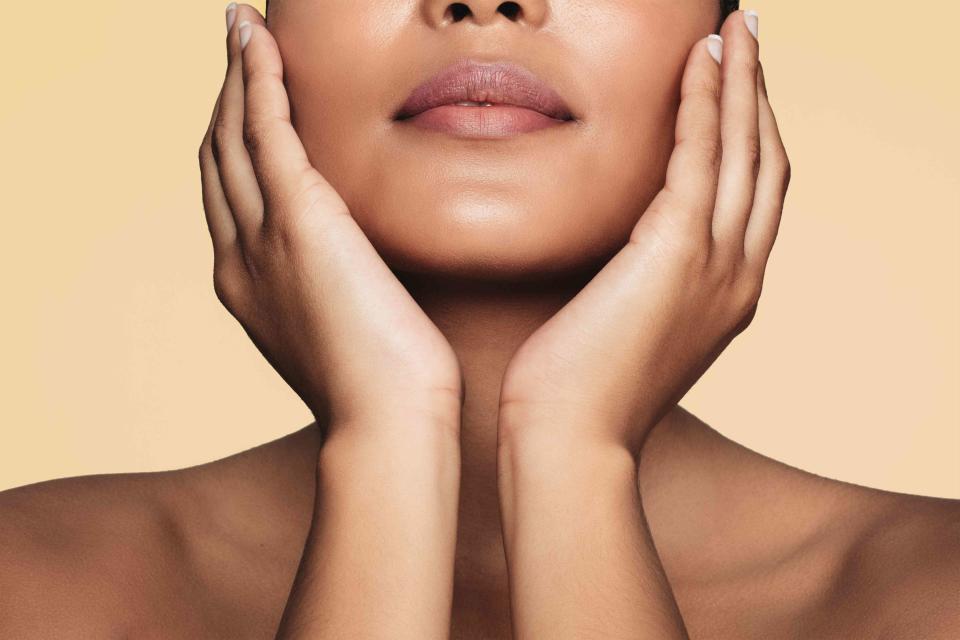Everything You Need to Know About Getting a Professional Dermaplane Facial
The fast track to getting baby skin.

Jacoblund/Getty Images
If you look closely at your face, even without a magnifying mirror, you’ll notice that it’s covered in baby fine peach fuzz referred to as vellus hairs. Dermaplaning is the process of gently removing these hairs with a sharp blade, and the treatment can help your skin look smoother and brighter. We spoke to a couple skincare pros about what dermaplaning is and how it works, what the pros and cons are, and whether it’s worth getting this treatment done.
RELATED: Everything You Need to Know About Dermaplaning at Home
What Is Dermaplaning?
Dermaplaning is a non-invasive, safe treatment that involves removing unwanted vellus hairs and dead skin cell buildup from the surface of your skin. This treatment typically targets the peach fuzz on your face. Professional, in-office dermaplaning usually involves a sharp, sterilized scalpel, though there are at-home tools you can purchase, as well.
“There are home versions that are sort of like an electric razor or disposable single use razors, which give a similar, non-invasive exfoliation,” explains Hayley Wood, a licensed holistic esthetician at The New Knew. “However, the professional dermaplane blades are sharp and must be disposed of in a sharps container, so it's [ideally] a procedure that needs to take place in a professional office.”
Benefits of Dermaplaning
If you can’t see the little hairs on your face, then what’s the point of removing them? Dermaplaning actually has quite a few notable benefits, which is why it’s gained so much popularity in recent years.
Exfoliates: Though it’s not quite as aggressive as chemical peels or physical scrubs, dermaplaning provides gentle exfoliation.
Brightens: Skin naturally looks brighter with the vellus hairs removed. This is because the peach fuzz no longer absorbs the light, and your skin can shine through and allow for light to bounce off it.
Improves Product Delivery: “When dermaplaning is done lightly on the topical layers of skin, it can help to remove any blockage on the skin allowing other treatments penetrate deeper,” explains Richard Bottiglione, MD, FAAD, a board-certified dermatologist in Arizona and founder of Derm Choice Skincare.
Easier Makeup Application: A smoother canvas can also help your makeup products glide on more easily. Some people say their skin looks smoother and makeup looks better after a dermaplane treatment.
Dermaplaning Drawbacks
While dermaplaning is very safe and tons of people swear by it, there are some potential drawbacks to consider. The biggest one is post-treatment irritation, which occurs anytime you’re exfoliating the skin or creating some friction. This irritation may look like redness or light breakouts. Some people also experience dryness, so fuel up on moisturizer.
Because there’s a sharp blade involved, there’s also a risk of cuts or scrapes. This is unlikely when it’s done professionally, but still something to be aware of. If you do get a cut, bacterial infections can become an issue; cleaning the area thoroughly is a must.
What Is a Professional Dermaplaning Treatment Like?
Before a professional dermaplaning treatment, your skin is washed and prepped with alcohol to remove excess oils and ensure a clean surface.
“Next, a gloved professional performs the dermaplane on dried skin by sectioning off areas—forehead, cheeks, upper lip and chin—and gently scraping off the dead skin,” Wood says. “It should almost feel like a soft touch or tickle. When done right, it's actually pretty relaxing. After the dermaplane is done, you can apply hydrating products to help the skin appear plump and glowy.”
She adds that there’s no down time and your dermaplaning treatment can often be added to another facial service, such a gentle chemical peel or moisturizing treatment.
How Long Does Dermaplaning Last?
Similar to other types of temporary hair removal, like shaving or waxing, your hair’s gonna grow back. Dr. Bottiglione says you can expect results to last about one or two weeks, maybe three, before needing to have the treatment performed again.
If exfoliation is your main goal, then he recommends a more aggressive in-office peel and/or weekly exfoliating treatments at home via enzyme or AHA masks. If the exfoliation is simply an added bonus to the hair removal, then schedule your dermaplaning appointments once every two to four weeks.
For more Real Simple news, make sure to sign up for our newsletter!
Read the original article on Real Simple.

